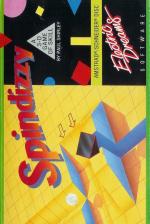
Amstrad Action
 1st March 1986
1st March 1986
Categories: Review: Software
Publisher: Electric Dreams
Machine: Amstrad CPC464
Published in Amstrad Action #6
Spindizzy
The success of a game called Marble Madness in the arcades and the emergence of the Amstrad as a leader in the computer games field combine here to produce an original game that will have other machine owners salivating like Pavlovian dogs to get at your Amstrad. Spindizzy combines marvellous graphics, testing puzzles and a large playing area to make a stunningly original and challenging game.
Gyroscope was the first attempt at a game like this, but is easily surpassed by the complexity of this latest game. You control a spinning top in its journey around the 400 odd screens that make up a weird world of puzzling action where a swift and steady hand on the joystick is required. The aim is to collect jewels that are tucked away on most of the screens, often in seemingly impossible spots to reach.
Control of your top is very sensitive - it responds to every twitch on the joystick. But once you've got the hang of that, it makes it a highly manoeuverable and speedy tool. The landscape doesn't help out most of the time either with steep slopes, narrow ledges, high wails, gaps in the floor, tight corridors, long drops and treacherous surfaces all awaiting you. The early games will be spent exploring this environment and wondering at its constant string of surprises.

Once you've got to grips with all that, the finer points of movement can be dealt with. The most important detail is the power provided by the fire button that can give the top rapid acceleration in a short space to propel it past some danger. There will also be times when it will need to be nudged very slowly about in tight spots where speed will be fatal.
The whole exercise is performed against the clock which gradually ticks down, but is pushed back up every time a jewel is collected. If, while trying to leap over a gap in the floor or sneak along a ledge, the top should plunge to its doom then time is knocked off the clock and the top restarts from where it fell off. Falling too far to the ground will also lose time and the top will explode in four pieces.
All of this is impressive enough... but it's when you start discovering the game's special features that your jaw really drops open. These include special puzzle features, a map function, view switching and a green screen option. The map and the view switching make it much easier to get around and locate the jewels with the map showing where an uncollected jewel is located once you've been in the room and the view switching allowing you to see the screen from four angles in order to locate any hidden jewels. This is very necessary since the screens are all in delightful 3D and high walls and slopes can often obscure the view. To prevent you becoming disorientated, a compass always points the way north.

Graphically, the game is superb with brilliantly designed screens in many different colours all composed of the geometric building blocks. Sound is limited to the odd effect, but these are well done and alert you to things happening. The gameplay is tough to get to grips with but soon becomes a joy and a constant challenge. It will be some while before anyone cracks this game, but I guarantee you won't be able to stop playing for weeks after buying it!
Second Opinion
Fiendishly compulsive and graphically superb, this is a knockout Mastergame. It's about time someone caught up with another corking Amstrad original - Electric Dreams will get their reward right now as well in heaven.
The sheer size is impressive enough, but it's executed with enough brilliance to make it an instant classic. Once you've got the feel of the controls, you're unlikely to stop until you've cracked it. And that could be quite some time.
Good News

P. About 400 screens to explore.
P. Stunning graphics and screen designs.
P. Testing puzzles and traps.
P. Good view switching facility.
P. Some extremely difficult screens but very easy to get into.
P. Knocks spots off Gyroscope (and we thought that was good!).
Bad News
N. Amstrad only. Ha, ha, ha!
Amstrad Rules OK
This is an original title that will doubtless undergo conversion to other micros - but they won't be as impressive or have as much impact as this is going to. We are undoubtedly seeing the emergence of the Amstrad as a leader in games development rather than just a machine to be converted to. It may take all of 1986 to complete the transition but there's no doubt it is happening.
Yie Ar Kung-Fu was another enormously impressive game that came out on the Amstrad first and Amsoft are continuing to improve their games and produce original ones like Tank Command, Doors Of Doom and Golden Path. Z80 programmers are beginning to see the increased potential of the Amstrad and are switching development of games from Spectrum to Amstrad as the market grows.
The utilities and hardware market is already more active and fast moving than for other machines and games are going the same way. 1986 is definitely the year of the Amstrad.
Other Reviews Of Spindizzy For The Amstrad CPC464
Spindizzy (Electric Dreams)
A review by Mike Roberts (Computer Gamer)
Spindizzy (Electric Dreams)
A review
Spindizzy (Electric Dreams)
A review





